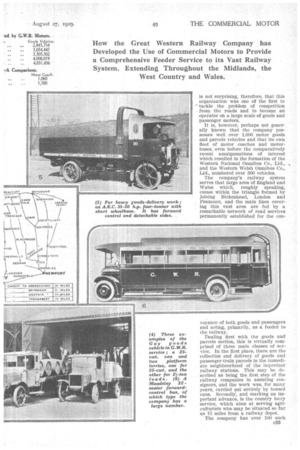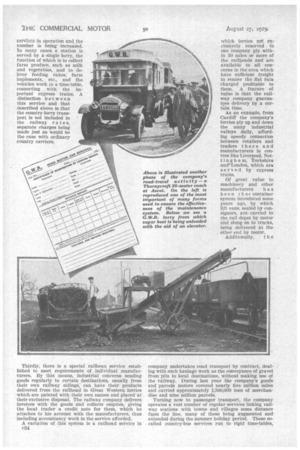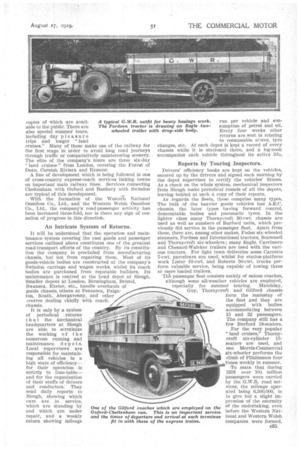ROAD-MOTOR SERVICES
Page 54

Page 55

Page 56

Page 57

If you've noticed an error in this article please click here to report it so we can fix it.
of a Great
Railway Organization
PERHAPS the most crucial factor bearing upon the progress taking place in the commercial-motor industry to-day is the relationship between road transport and rail transport, both of passenger traffic and of goods. For many years the railway companies in Great Britain carried the bulk of merchandize between industrial towns and the ports, as well as practically the entire inter-town passenger traffic of the country. With the development of road transport and the reduction in operating costs of large road vehicles propelled by steam or the internal-combustion engine a rival to the permanent way has rapidly come into existence.
Great Britain is not a large country, but the distances between many of its important industrial centres are sufficiently great to give the main railway lines an economical priority by reason of the larger load which can be transported on them by a single power unit, coupled with the fact that for the development of very high power the steam engine is at present more cheaply operated than most forms of internal-combustion engine.
For shorter distances and small loads, however, the road vehicle, and particularly that propelled by the petrol motor, has attained a position of pre-eminence, so that the great companies, the main concern of which is the operation of steam rail systems, have for some years been obliged to interest themselves in road transport, and especially in the commercial motor.
The Great Western Railway-Co. is one of the largest railway organizations of Britain and possesses on its strength some of the country's best engineering and financial brains. It c32 is not surprising, therefore, that this organization was one of the first to tackle the problem of competition from the roads and to become an .operator on a large scale of goods and passenger motors.
It is, however, perhaps not generally known that the company possesses well over 1,000 motor goods and parcels vehicles and that its own fleet of motor coaches and motorbuses, even before the comparatively recent amalgamations of interest which resulted in the formation of the Western National Omnibus Co., Ltd., and the Western Welsh Omnibus Co., Ltd., numbered over 300 vehicles.
The company's railway system serves that large area of England and Wales which, roughly speaking, comes within the triangle formed by joining Birkenhead, London and Penzance, and the main lines covering this vast area are fed by a remarkable network of road services permanently established for the con
veyance of both goods and passengers and acting, primarily, as a feeder to the railway.
Dealing first with the goods and parcels section, this is virtually comprised of three main classes of service. In the first place, there are the collection and delivery of goods and passenger-train parcels in the immediate neighbourhood of the
important railway stations. This may be described as being the first step of the railway companies in assisting consignors, and the work was, for many years, carried out entirely by horsed vans. Secondly, and marking an important advance, is the country lorry. service, which aims at serving agriculturists who may be situated so far as 15 miles from a railway depot. The company. has over 100 such c33
Vervia..-3 in operation and the number is being increased. In many cases a station is served by a .single lorry, the function of which is to collect farm produce, such as milk and vegetables, and to deliver feeding cakes, farm implements, etc., and the vehicles work to a time-table, connecting with the important express trains. A distinction bet we an this service and that described above is that the country-lorry transport is not included in the railway rate s, separate charges being made just as would be the case with ordinary country carriers.
Thirdly, there is a special railhead service established to meet requirements of individual manufacturers. By this means, industrial concerns sending goods regularly to certain destinations, usually from their own railway sidings, can have their products delivered fromthe railhead in Great Western lorries which are painted with their own names and placed at their exclusive disposal. The railway company delivers Invoices with the goods and collects empties, giving the local trader a credit note for them, which he attaches to his account with the manufacturers, thus including accountancy work in the service afforded.
A variation of this system is a railhead service in (14
which lorries not exclusively reserved to one company ply, within 30 miles or more of
• the railheads and are available to all concerns in the area which have sufficient freight to render the fiat rate charged profitable to them. A feature of value is that the railway company guarantees delivery by a certain time.
As an example, from Cardiff the company's lorries ply up and down the many industrial valleys daily, affording speedy connection between retailers and traders there and manufacturers in centres like Liverpool, Nottingham, Yorkshire and London, which are served by express trains.
Of great value to machinery and other manufacturers h a s been they container system introduced some years ago, by which lift vans, sealed by consignors, arecarried to the rail depot by motor and slung on to trucks, being delivered at the Other end by motor.
Additionally, t h c company undertakes road transport by contract, dealing with such haulage work as the conveyance of gravel from pits to local destinations, without making use of the railway. During last year the company's goods and parcels motors covered nearly five million miles and carried approximately 1,500,000 tons of merchandise and nine million parcels.
Turning now to passenger transport, the company operates a vast number of regular services linking railway stations with towns and villages some distance from the line, many of these being augmented and extended during the summer holiday period. These socalled country-bus services run to rigid time-tables, copies of which are available to the public. There are also special summer tours, including day pleasure trips and longer " land cruises." Many of these make use of the railway for the first stage in order to avoid long road journeys through traffic or comparatively uninteresting scenery. The elite of the company's tours are three six-day "land cruises '! from London, covering the Forest of Dean, Cornish Riviera anti Exmoor.
A line of development which is being followed is one of cross-country express-coach services linking towns on important main railway lines. Services connecting Cheltenham with Oxford and Banbury with Swindon are typical of this development.
With the formation of the Western National Omnibus Co., Ltd., and the Western Welsh Omnibus Co., Ltd., the company's road-passenger activity has been increased three-fold, nor is there any sign of cessation of progress in this direction.
An Intricate System of Returns.
It will be understood that the operation and maintenance system covering the vast goods and passenger services outlined above constitutes one of the greatest road-transport efforts of the country. By its constitution the company is precluded from manufacturing chassis, but not from repairing them. Most of its goods-vehicle bodies are constructed at the company's Swindon carriage and wagon works, whilst its coach bodies are purchased from reputable builders. Its maintenance is centred at the head depot at Slough. Smaller 'depots. at London, Birmingham, Bristol,
Swansea, Exeter, etc., handle overhauls of goods chassis, others at Penzance, Paignton, Neath, Abergavenny, and other centres dealing chiefly with coach. chassis.
It is only by a system of periodical . returns tk a t the mechanical headquarters at Slough are able• to scrutinize the working of the numerous running and maintenance d ep ot s. Local supervisors are responsible for maintaining all vehicles in a high state of efficiency— for their operation is strictly to time-table-and for the organization of their staffs of drivers and conductors. They send daily reports to Slough, showing which cars are in service, which are standing by and which are under repair, and a weekly return showing mileage run per vehicle and consumption of petrol and oil. Every four weeks other returns are sent in relating to consumable stares, tyre changes, etc. At each depot is kept a record of every chassis while it is stationed there, and a log-book accompanies eaCh vehicle throughout its active life.
Reports by Touring Inspectors.
Drivers' efficiency books are kept on the vehicles, entered up by the drivers and signed each morning by the depot supervisor to certify the vehicles' fitness. As a check on the whole system, mechanical inspectors from Slough make periodical rounds of all the depots, leaving behind at each a copy of their reports.
As regards the fleets, these comprise many types. The bulk of the heavier goods vehicles has A.E.C. chassis, the later types having forward control, demountable bodies and pneumatic tyres. In the lighter class many Thornycroft 30-cwt. chassis are used as well as numbers of Burford units, which previously did service in the passenger fleet. Apart from these, there are, among other makes, Foden six-wheeled steamers, Fordson and International tractors, Scammell and Thornycroft six-wheelers; many Eagle, Carrimore and Chenard-Walcker trailers are used with the various tractors. For light town deliveries some Carrette 7-cwt. parcelcars are used, whilst for station-platform work Lister 10-cwt. and Roberts 30-cwt. trucks perform valuable service, being capable of towing three or more loaded trailers.
The passenger fleet consists mainly of saloon coaches, although some all-weather vehicles are employed, especially for summer touring. Maudslay, Guy, Thornycroft and Gilford chassis form the mainstay of the fleet and they are equipped with bodies accommodating between 15 and 32 passengers. The company still has a few Burford 18-seaters.
For the very popular " land cruises," Thornycroft six-cylinder 15seaters are used, and one Morris-Commercial six-wheeler performs the climb of PIinlinunon four times weekly in summer.
• To state that during 1928 over 10-i million passengers were carried by the G.W.R. road services, the mileage operated being 6,500,000, is to give but a slight impression of the enormity of the undertaking, even before the Western National and Western Welsh companies were formed.












































































































